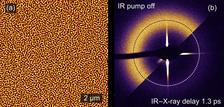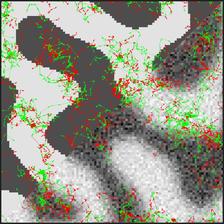Figure 1
(a) Magnetic force microscopy (MFM) image of the magnetic labyrinth domain pattern exhibited by the thin-film Co/Pt multilayer structure. The magnetization of the domains is alternately pointing up or down, perpendicular to the magnetic film.
(b) Related magnetic small-angle X-ray scattering pattern of the domains. The image shows a comparison of the pattern in the equilibrium (unpumped) state and after the sample was pumped by an IR laser. The dotted lines highlight the peak radius.
Bastian Pfau1, Stefan Schaffert1, Leonard Müller2, Christian Gutt2, Alaa Al-Shemmary2, Felix Büttner1,3,4,5, Renaud Delaunay6, Stefan Düsterer2, Samuel Flewett1,4, Robert Frömter7, Jan Geilhufe8, Erik Guehrs1, Christian M. Günther1, Ranjit Hawaldar6, Matthias Hille7, Nicolas Jaouen9, Aandré Kobs7, Kaigong Li6, Jyoti Mohanty1, Harald Redlin2, William F. Schlotter10, Daniel Stickler7, Rolf Treusch2, Boris Vodungbo6,11, Mathias Kläui3,4,5, Hans Peter Oepen7, Jan Lüning6, Gerhard Grübel2, Stefan Eisebitt1,8
- TU Berlin, Institut für Optik und Atomare Physik, 10623 Berlin, Germany
- Deutsches Elektronen-Synchrotron DESY, 22607 Hamburg, Germany
- Johannes Gutenberg-Universität Mainz, Institut für Physik, 55099 Mainz, Germany
- SwissFEL, Paul Scherrer Institut, 5232 Villigen PSI, Switzerland
- École Polytechnique Fédèrale de Lausanne, 1015 Lausanne, Switzerland
- Université Pierre et Marie Curie, Laboratoire de Chimie Physique – Matière et Rayonnement – CNRS UMR 7614, 75005 Paris, France
- Universität Hamburg, Institut für Angewandte Physik, 20355 Hamburg, Germany
- Helmholtz-Zentrum Berlin für Materialien und Energie, 14109 Berlin, Germany
- Synchrotron SOLEIL, L’Orme des Merisiers, Saint-Aubin, 91192 Gif-sur-Yvette Cedex, France
- Linac Coherent Light Source, SLAC National Accelerator Laboratory, Menlo Park, California 94025, USA
- Laboratoire d’Optique Appliquée, ENSTA ParisTech – CNRS UMR 7639 – École polytechnique, Chemin de la Hunière, 91761 Palaiseau, France
Published as: “Ultrafast optical demagnetization manipulates nanoscale spin structure in domain walls”, Nature Communications 3, 1100 (2012).
When a magnetized material is bombarded by a femtosecond infra-red laser pulse, the magnetization of the material drops within a few hundreds of femtoseconds. In a study using ultrashort X-ray pulses delivered by FLASH we investigate the process of ultrafast demagnetization in a sample exhibiting nanometer-sized magnetic domains. In the pump-probe experiment the evolution of the magnetization is monitored with femtosecond time resolution and nanometer spatial resolution. The results together with simulations suggest that superdiffusive spin transport between adjacent magnetic domains contributes to the ultrafast demagnetization and significantly changes the spin structure at the domain walls.
In 1996 Beaurepaire et al. reported on an experiment [1] which opened a new field of magnetism research. It was observed that the magnetization of a nickel film after being pumped by an optical femtosecond laser pulse drops on a timescale of a few hundred femtoseconds. This magnetization change is orders of magnitude faster than expected by classical magnetization dynamics typically taking place on the nano- and picosecond timescale. Since the discovery of the ultrafast demagnetization process, its mechanism has been intensely debated. So far, most experimental as well as theoretical work has focused on homogeneous samples in order to understand the intrinsic demagnetization mechanisms. In particular, the transport of energy and angular momentum between the light pulse used for excitation, the electrons, their spin configuration and the crystal lattice with its phonon excitations have to be addressed. The electron spin is intimately linked to the samples magnetization.
Additional extrinsic demagnetization channels due to a heterogeneous sample structure and resulting interfaces have been considered so far only for layered thin-film samples with interfaces between ferromagnetic and paramagnetic layers [2]. Recently, it was proposed in a theoretical study, that superdiffusive spin transport could significantly contribute to the ultrafast demagnetization [3]. This concept is based on the notion that the lifetimes, velocities and, consequentially, the mean free paths for hot electrons in metals are spin dependent if the electrons move in a magnetized region. As electrons carrying the majority spin possess a much higher mobility than the minority electrons, the majority electrons may preferentially leak from a ferromagnetic layer into an adjacent layer leading to a demagnetization of the ferromagnetic layer. Moreover the effective transport of spin may even change the magnetization in the destination layer [4].
In our study we investigate ultrafast demagnetization in a thin film Co/Pt multilayer sample which is magnetized in the out-of plane direction. In the remanent equilibrium state the magnetic film exhibits a nanoscale labyrinth-like pattern of magnetic domains with the magnetization pointing either “up” or “down” (Fig. 1a). The boundaries between the domains, the domain walls, are purely magnetic in nature as the sample is laterally homogeneous with respect to elemental composition.
The pump-probe experiment has been performed at the free electron laser FLASH. The sample was pumped by a 70 fs long infra-red (IR) laser pulse and after a certain delay time (0-15 ps), the magnetic state of the sample was probed by a 100 fs long soft X-ray pulse. The ultrashort pump and probe pulses allow to investigate the evolution of the magnetization on a sub-ps timescale. The magnetic sensitivity is obtained via the X-ray magnetic circular dichroism effect. This effect gives rise to a magnetization-dependent X-ray absorption if the wavelength of the radiation is tuned to a suitable absorption edge of the magnetized material. Due to the alternating arrangement of oppositely magnetized domains, the magnetic layer acts as a diffraction grating and intensity maxima on the side of the directly transmitted radiation are observed in the diffraction pattern of the sample. Changes in the shape of this diffraction ring can be used to identify modifications in the domain arrangement with nanometer resolution.
As depicted in Fig. 1b, the intensity of the diffraction ring drastically reduces after the sample is pumped by the IR pulse. This finding is directly explained by the ultrafast demagnetization of the magnetic material. In addition, we observe a reduction of the scattering ring radius by about 4 %, which must be directly related to spatial changes in the magnetic domain pattern.
In order to explain our observation, we have performed Monte-Carlo simulations of the spin-dependent lateral motion of hot electrons in the magnetic film characterized by the presence of magnetic domains (Fig. 2). The simulations reveal that hot majority electrons which diffuse in the domain pattern get trapped when they have crossed a domain wall. The reason for this behaviour is their reduced mobility once they have become a minority electron by entering the adjacent domain. The accumulation of minority spin at the walls leads to a magnetic softening of the boundaries. A simulation of the scattering experiment shows that this domain wall softening explains the reduction of the diffraction ring radius.
We anticipate that it will be possible to tailor time constants of optical demagnetization by variation of the domain size or by specific nanostructuring [5]. Given the tremendous advances in the use of magnetic interfaces for electronic and spintronic applications in the past decades, one may envision the utilization of superdiffusive spin transport across ferromagnetic domain walls for ultrafast magneto-optical devices in the future.
| References | ||||||||||
|
| Contact information |
|
Stefan Eisebitt |
| Further Information |








